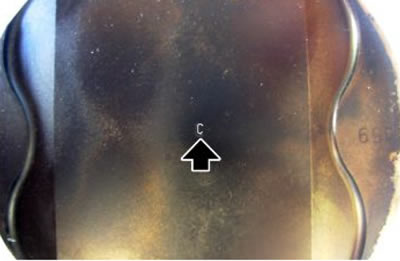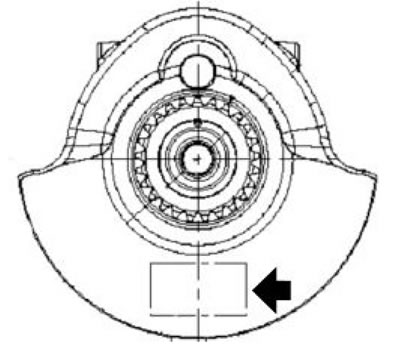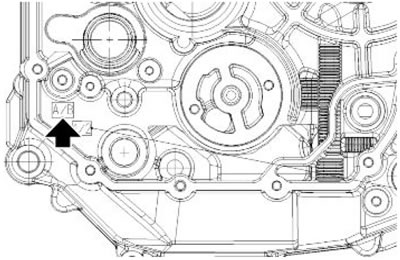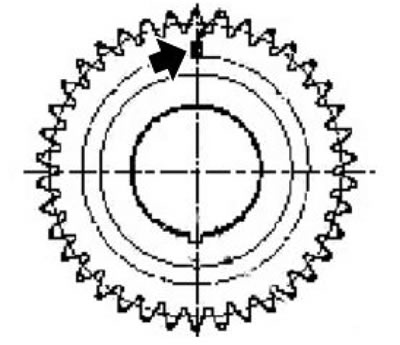Cylinder - piston assy
The pistons are available in four size types (A, B, C, D) to be coupled to the four cylinder types (A, B, C, D).
Only one type of piston ring is available.
 |  |
Cylinder - piston coupling
| Specification | Desc./Quantity |
| Piston - cylinder coupling Type A | Cylinder: 91.990 - 91.977 mm (3.6216 - 3.6219 in) Piston: 91.933 - 91.940 mm (3.6217 - 3.6197 in) |
| Piston - cylinder coupling Type B | Cylinder: 91.997 - 92.004 mm (3.6219 - 3.6222 in) Piston: 91.940 - 91.947 mm (3.6197 - 3.6199 in) |
| Piston - cylinder coupling Type C | Cylinder: 92.004 - 92.011 mm (3.6222 - 3.6225 in) Piston: 91.947 - 91.954 mm (3.6199 - 3.6202 in) |
| Piston - cylinder coupling Type D | Cylinder: 92.011 - 92.018 mm (3.6225 - 3.6227 in) Piston: 91.954 - 91.961 mm (3.6202 - 3.6205 in) |
| Fitting clearance | 0.050 - 0.064 mm (0.00197 - 0.00252 in) |
Crankcase - crankshaft - connecting rod
Internal marking on first generation crankcases
Crankcases are classified in two classes (1 or 2) depending on the diameter of the main bearing seat. The class is indicated on both crankcase halves, specifically, in the rear cylinder area on flywheel side crankcase halves and in the front cylinder area on clutch side crankcase halves.

Crankcase classes
| Specification | Desc./Quantity |
| Crankcase class 1 | Bushing seat diameter: 53.954 - 53.960 mm (2.1241 - 2.1244 in) |
| Crankcase class 2 | Bushing seat diameter: 53.960 - 53.966 mm (2.1244 - 2.1246 in) |
Internal marking on second generation crankcases
Crankcases are classified in two classes (1 or 2) depending on the diameter of the main bearing seat. The class is indicated on both crankcase halves, specifically, in the starter gear area on flywheel side crankcase halves and in the gearbox control mechanism area on clutch side crankcase halves.

There are three crankshaft classes selectable for each bearing:
- 4 - 5 - 6 for the flywheel side;
- 7 - 8 - 9 for the clutch side;
The class is stamped on the outer face of the crankshaft counterweight.

Note. Two different crankshaft classes may be possible on the two bearings.
Crankshaft classes
| Specification | Desc./Quantity |
| Crankshaft classes 4 - 7 | Main journals - diameter: 49.978 - 49.984 mm (1.9676 - 1.9679 in) |
| Crankshaft classes 5 - 8 | Main journals - diameter: 49.972 - 49.978 mm (1.9674 - 1.9676 in) |
| Crankshaft classes 6 - 9 | Main journals - diameter: 49.990 - 49.984 mm (1.9681 - 1.9679 in) |
Once the categories below are checked:
- crankcase
- flywheel side main journal
- clutch side main journal
Choose the bushings used for assembly from the following table.
Main bushings
| Main journal | Crankcase class 1 | Crankcase class 2 |
| Class 4 main journal (l.v.) | Semi-bushing type A (red) | Semi-bushing type B (blue) |
| Class 5 main journal (l.v.) | Semi-bushing type B (blue) | Semi-bushing type C (yellow) |
| Class 6 main journal (l.v.) | Semi-bushing type E (green) | Semi-bushing type A (red) |
| Class 7 main journal (l.f.) | Semi-bushing type A (red) | Semi-bushing type B (blue) |
| Class 8 main journal (l.f.) | Semi-bushing type B (blue) | Semi-bushing type C (yellow) |
| Class 9 main journal (l.f.) | Semi-bushing type E (green) | Semi-bushing type A (red) |
Crankcase class (internal marking on first generation crankcases)
Two different crankcase classes (A or B) are available, selected in relation to the centre-to-centre distance between the primary reduction gears.
The class is indicated on the clutch side crankcase half near the front cylinder area.

Note. In the event of crankcase replacement, the primary reduction gear is supplied ready meshed.
Crankcase classes 01
| Specification | Desc./Quantity |
| Crankcase class A | Centre-to-centre distance: 110.50 - 110.54 mm (4.3504 - 4.3519 in) |
| Crankcase class B | Centre-to-centre distance: 110.46 - 110.50 mm (4.3488 - 4.3504 in) |
Crankcase class (internal marking on second generation crankcases)
Two different crankcase classes (A or B) are available, selected in relation to the centre-to-centre distance between the primary reduction gears.
The class is indicated on the clutch side crankcase half, in the gearbox control mechanism area.

Note. In the event of crankcase replacement, the primary reduction gear is supplied ready meshed.
Crankcase classes 02
| Specification | Desc./Quantity |
| Crankcase class A | Centre-to-centre distance: 110.50 - 110.54 mm (4.3504 - 4.3519 in) |
| Crankcase class B | Centre-to-centre distance: 110.46 - 110.50 mm (4.3488 - 4.3504 in) |
Class one
Two different pinion classes (A or B) are available, selected in relation to the centre-to-centre distance between the primary reduction gears.
On class B pinions only, the class is indicated on the pinion itself.

Crankshaft class (crank pin)
There are four different classes of crankshaft available (0, 1, 2, 3), selected in relation to crank pin diameter.
There are four different classes of crankshaft available (E1, E2, ...) selectable in relation to connecting rod weight.

Key:
- Class according to connecting rod weight.
- *Class according to crank pin diameter.
- **Serial number for traceability and indicating date.
Shaft category
| Class | Crank pin diameter (mm) |
| 0 | 42.000 - 42.006 mm (1.65354 - 1.65377 in) |
| 1 | 41.994 - 42.000 mm (1.65330 - 1.65354 in) |
| 2 | 41.988 - 41.994 mm (1.65307 - 1.65330 in) |
| 3 | 41.982 - 41.988 mm (1.65283 - 1.65307 in) |
Selecting bushings
There is only one dimension class for the connecting rod. As a result, the bushings used must be selected in accordance with the dimension class of the crank pin.
Bushings
| Crank pin diameter | Connecting rod class 1 |
| Crankshaft class 0 | Semi-bushing type E (green) |
| Crankshaft class 1 | Semi-bushing type A (red) |
| Crankshaft class 2 | Semi-bushing type B (blue) |
| Crankshaft class 3 | Semi-bushing type C (yellow) |
Selecting connecting rods
Not all weight classes are available as spare parts. Only the two most significant weight classes are available - refer to the following table for selection:
Connecting rods
| Class according to crankshaft weight | Original connecting rod class |
| E1 | Brown connecting rod |
| E2 | Blue connecting rod |
| E3 | Yellow connecting rod |
| E4 | Green connecting rod |
| E5 | Pink connecting rod |
| E6 | Black connecting rod |
| E7 | White connecting rod |
Caution!
- The connecting rods installed on the same engine must be of the same colour and must use the same type of assembly with the crankshaft.
- When refitting, also ensure that the semi-bushings are all of the same class.
